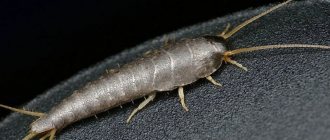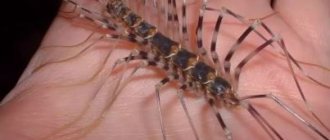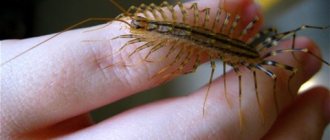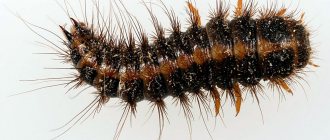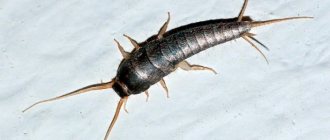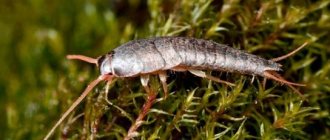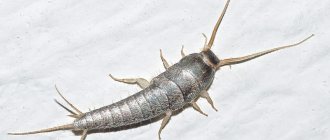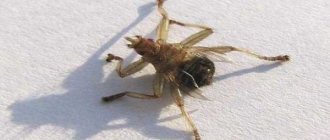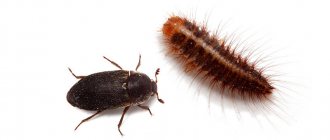The common silverfish or sugar silverfish (Lepisma saccharina) is a small insect that lives in apartments or houses. Many people do not notice it until the number of insects reaches 100-150 individuals. This is justified by the fact that this pest is invisible, in addition, the damage from it is quite insignificant.
Common silverfish (sugar silverfish)
Appearance of silverfish
To notice such a small and inconspicuous insect, you should familiarize yourself with its external characteristics. Adults reach a body length of up to 1.9 cm (without antennae). Because they grow throughout their lives, the size of most silverfish ranges from 0.8 to 1.2 cm.
The body of the pest is quite flat, the head barely stands out against the background of the rest of the body. The chest is wide. The body gradually tapers towards the tail, and also has a subtle division into segments. It is covered with scales that change color during the molting process.
The most common type of silverfish is the common silverfish or sugar silverfish.
Among the shades are:
- dark brown (up to almost black);
- pale brown or dirty yellow (more common in young insects);
- light yellow or white (relatively rare color);
- silver (the body of such a representative has a bright, cold tint).
The silverfish has long, thick antennae that point forward and diverge slightly to the sides. In addition, a distinctive feature of this insect is the three threads at the end of the tail. These threads are extremely similar to antennae. The silverfish has three pairs of short but thick legs. The eyes of the pest are complex, faceted.
Why is silverfish dangerous? What harm does it cause?
Silverfish, contrary to popular belief, do not pose a threat to humans. It does not carry diseases and does not bite or sting. Thus, the insect does not pose a serious danger.
With a small number of individuals, silverfish practically do not spoil things, that is, they do not interfere with the owner of the house in any way.
But still, this insect is considered to be a pest. This is justified by the following facts:
- The silverfish population is rapidly increasing, so the damage is becoming more noticeable. These insects chew through packages and damage books, linen and curtains. They can also further worsen the condition of old wallpaper or rotten wood.
- Laying eggs and remaining adults in human food. Although silverfish are not carriers of diseases, they can reduce the quality of food to the point where it becomes completely inedible. In addition, the pest, constantly moving, collects dirt and dangerous microorganisms on its own body. It can be dangerous if it gets into human food.
- The appearance, abundance and rapid movement of silverfish irritate people. The insect sometimes gets into the bed, inside the refrigerator, into the sugar bowl or other places. This makes people very nervous, disgusts them, ruins their sleep and reduces their performance.
This pest, despite being picky about living conditions, is highly resilient. Destroying a population that has settled somewhere is quite problematic. This is another reason why the insect is classified as a pest. This survival of silverfish is justified by the fact that it is most likely the ancestor of modern insects. Judging by the remains found, the pest has existed for about 400 million years. This fact is the main indicator of the survivability of this insect.
It is believed that silverfish are most dangerous for museums and libraries. In these places there is a lot of food, which is valuable for the insect, as well as various cracks and dark corners. For this reason, both museums and libraries follow strict rules regarding indoor humidity levels.
Chemicals
Gels
There are a variety of insect repellent gels on the market. With different composition, methods of use, shelf life.
There are strict storage rules for them:
- Out of reach of children;
- At a temperature of no more than 25-30 degrees;
- In a dry and dark room.
Let's celebrate! Popular types of remedies: Demon; Safer; Deco. They have a lower percentage of toxicity. Do not use in places where pets are constantly present. Requires re-treatment of the surface after 2-3 weeks.
Crayons and pencils
The Russian market contains many products for exterminating insects and pests. Among them are chemical pencils.
They have a number of advantages:
- low cost (from 35-80 rubles);
- simplicity and economy of use;
- Unlike aerosol, it does not have such an intense and poisonous odor.
Popular types: Mashenka; Brownie; Tornado. Used according to the following method:
- Coverage areas: baseboards; cracks; chips; thresholds; window openings;
- The strip should not be more than 1 centimeter;
- It is advisable to make a continuous strip.
Fumigators
A fumigator is a device for repelling parasites and insects. Operates from a 220 volt network. It is a small plastic device that plugs into an outlet.
It has recesses through which an unpleasant odor and enzyme are released and distributed. The substance contains elements harmful to insects.
Good to know! Fumigators are electrical and pyrotechnic. Pyrotechnics must be set on fire to spread the poison. They are absolutely safe for people and animals living indoors.
Sticky traps
Special sticky traps are available for sale. They are made in different types. There are regular sticky ones, and electric ones with a sticky base. Some are adhesive rollers placed in crevices. Others are placed on the floor in damp rooms and consist of a box with adhesive tape on the bottom. Such traps can cost up to 300 rubles.
Life cycle and lifestyle of silverfish
Silverfish are nocturnal. During the daytime, adults hide or look for a place to lay eggs. At the moment, insects live mainly in human homes, but there are also wild representatives. The latter feed on algae, fungi, fallen leaves or lichen, hiding inside the bark or under the forest floor.
It should be noted that the most common species is the common silverfish, which is also called “sugar fish”. It received this name because of the insect's craving for sweets. This is justified by the fact that silverfish need glucose. Starch is also very important for it.
Despite the fact that the pest is omnivorous, it has some taste preferences:
- Human food. Often this is sugar, flour (both potato and wheat) or vegetables. The insect can lay eggs in cereals, because this place seems quite safe to it.
- Various things and objects. Silverfish can feed on clothing or books, or more precisely on fabrics, leather, and also wool. The pest especially loves starched linen.
- Decoration of the premises. Starting from old wood to glue. Most often, the diet includes wallpaper and upholstery.
This animal stands out for its gluttony. Moreover, it can live without food for up to 10 months. The main condition for survival for an insect is humidity. For this reason, silverfish often settle in the bathroom or toilet.
Any crack can become a refuge for a pest. Silverfish also settle under scraps of wallpaper, garbage, or directly in food (primarily flour). You can often see it under the sink or bathtub, where it is quite dark, warm and humid. Since the insect hates light, it is almost impossible to meet it during the daytime: the silverfish, even if it is busy reproducing, moves exclusively in darkened areas.
Although the pest is extremely demanding of humidity, it does not need water. Moreover, it is dangerous for this insect. The silverfish cannot swim and drowns when it gets into a drop of water. This is justified by the structure of its legs: they are too short for the animal to get out of the liquid.
In nature, silverfish travel long distances. She develops high speed, but gets tired quickly. Because of this, the insect moves quickly, taking short breaks. The pest spends a lot of time reproducing, so speed of movement is extremely important for it. The reason for this is the fact that direct mating between individuals of different sexes does not occur. The female looks for spermatophores left by males in a random place.
Silverfish are considered insects prone to rapid and efficient reproduction. The female lays about 70 eggs at a time. The percentage of surviving larvae is quite high, and they grow quickly.
The molting process is important for silverfish. In larvae, scale changes occur more frequently. In addition, the number of molts of this insect is unlimited. The change in color can be quite radical, and also does not always depend on the age of the individual.
Reasons for appearance
As a rule, silverfish appear in the bathroom when the microclimate is disturbed . Favorable conditions must be created in the room.
In most cases, silverfish enter the apartment through pipes, through open windows or cracks in the walls. In the bathroom, the insect appears if there is poor-quality ventilation or a lot of rubbish. If the humidity in the room is high, over time, in addition to sugar and other silverfish, woodlice, centipedes and spiders will appear.
How to get rid of silverfish?
If there is already a whole population in the house, chemicals are used. In addition, people set up homemade traps. The insect can also be repelled by strong odors.
To repel silverfish, you can use zest shavings and various strong-smelling spices: cinnamon, bay leaf, sage, etc. They need to be placed in cabinets. Essential oils will also help in the fight against insects. To do this, you need to take a spray bottle with water, add a few drops of lavender or citrus essential oil to it and spray the places where insects were encountered.
But such methods are ineffective, because they only repel insects, but do not kill.
It’s easy to make a trap against silverfish: you need to take a glass jar, wrap the outside of it with electrical tape, and put bait inside, for example, a piece of bread. The insects will try to get to the bait, climb into the jar, but will not be able to get out. Remember to periodically clean the trap and add new bait.
Another option is a newspaper trap. To make it, you need to wind the newspaper into a roll and tighten its edges with an elastic band. Next, you need to wet the newspaper and leave it overnight. At night, silverfish will probably crawl into the newspaper; in the morning you will need to throw it away.
If you don’t want to make a trap yourself, you can always purchase one at the store.
But one trap will be ineffective; this method of pest control is considered auxiliary, since it helps reduce the number of insects in the house. But if you do not take other measures, the silverfish will quickly multiply and restore their population.
One of the common methods in the fight against silverfish is diatomaceous earth. It should be scattered at night in places where the pest was found, and vacuumed in the morning.
Boric acid will help get rid of silverfish in an apartment or private house. It also needs to be scattered in places where insects accumulate.
Insecticidal aerosols based on pyrethrin are effective against various insects, including silverfish. But keep in mind that chemicals are dangerous not only for insects, but also for people and pets. They should be used strictly according to the instructions.
To eliminate silverfish in your home, it is recommended to carry out the following cleaning:
- Remove all trash and unnecessary items to gain access to all hard-to-reach places in the room.
- Carry out general cleaning, treat all objects with a cleaning agent containing chlorine. Wait until they dry.
- Apply a solution of copper sulfate and dry everything well. To keep moisture out of corners and hard-to-reach places, you can use a fan.
- Treat the room with aerosol preparations. Close it for an hour.
- Ventilate the room well.
For greater effect, it is recommended to repeat this cleaning and treatment after a few days.
It is much easier to prevent the appearance of silverfish in an apartment or house than to fight it. Therefore, preventive measures are recommended.
Where can insects appear in the house?
They can lick out from under baseboards or live under a bathtub or sink. It is not uncommon to see them on shelves with books or on kitchen window sills, as well as in sofas or even among clothes. For silverfish, the main thing is that it is dark and humid. It usually enters the house through a ventilation hole, cracks in the floors or near the entrance doors. It happens that a person himself brings them into the house along with some thing.
